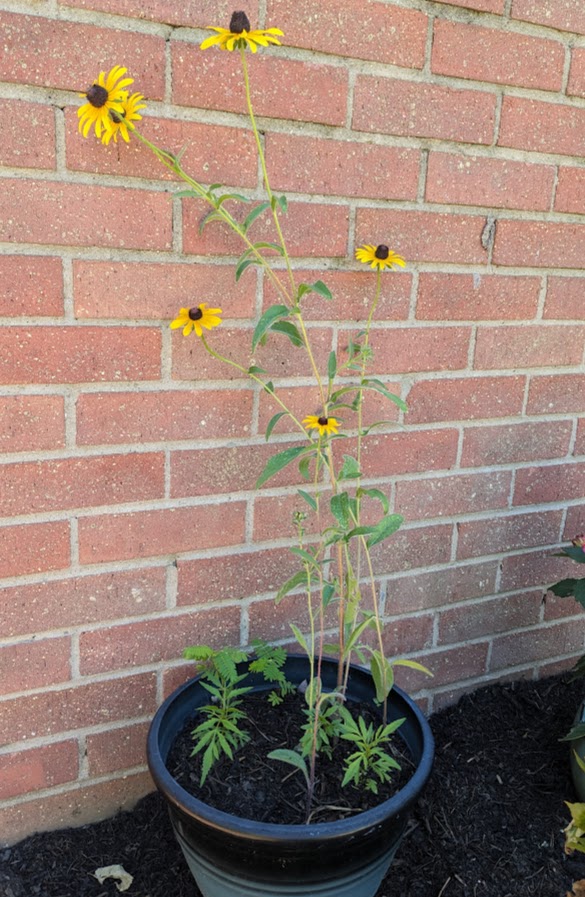
Not every plant-lover is fortunate enough to have a large yard space of their own for gardening.
Gardening in containers is a worthy pursuit for many reasons, no matter if it’s due to a lack of space, the fact that you’re a renter, or if you just have a patio or porch that you’d like to fill with plants.
And while a wide variety of pretty exotic ornamentals often take center stage in container gardens, there are plenty of native plants that can put on quite a show too, while at the same time providing crucial ecosystem services.
One native that I’ve found to work really well in containers is a classic: black eyed susan or rudbeckia hirta. Black eyed susans are one of the more popular US native wildflowers and are thus recognizable by a vast majority of gardeners, but when the conversation gets into particular species it’s a little more complicated. When we say black eyed susan, in fact, it’s not entirely clear if we’re talking about a perennial or annual. So let’s dig into that first.
Annual vs. Perennial vs. Biennial Black Eyed Susan (Rudbeckia)
There are quite a few black eyed susan species native to a large swath of the United States, but not all of them are perennials that return reliably each year. To make things even more complicated, there are actually perennials, annuals, and biennial species!
We’ll start with the first two categories. Clasping Sunflower (Rudbeckia amplexicaulis) is a good example of an annual black-eyed susan. Its leaves “clasp” or hold the stems which distinguish it from other species, and it’s an earlier bloomer (late spring to summer).
On the other end of the spectrum are rudbeckia fulgida, one of the more common longer-lived perennials, which also has multiple cultivars including the garden center staple “Goldstrum.” (“Deam’s Coneflower” is another naturally-occurring cultivar that is similar.) Sweet Black-eyed Susan (Rudbeckia subtomentosa) is another longer-lived perennial black-eyed susan. On average these perennials bloom a bit later in the season than the annual.
From there we get to the species of black eyed susan that I recommend planting in containers, rudbeckia hirta.
Rudbeckia hirta is technically a biennial, meaning that it flowers and completes its life cycle in the second year, but it very frequently flowers the first year, especially when seeded early in the season.
It’s pretty hit or miss whether it will return for a second year (in my experience they usually haven’t returned the following spring). But either way, they will self-seed readily, so you will most likely get plenty of new volunteers next year if you leave them in place after flowering.
Black Eyed Susan (Rudbeckia hirta) as an Annual in Pots
Because of these tendencies, I treat rudbeckia hirta as an annual when using it in a container setting.
In a pot it’s even less likely for the same plant to return in spring, but I do keep the seedheads intact and usually sprinkle some seeds into the pot during the winter months, which almost guarantees I’ll have more black eyed susans the next spring because they germinate very readily.
If you’re starting them by seed that you collected the previous year or buy as a seed packet, I recommend starting them very early in the spring. You can also engage in a “succession planting” of sorts by reseeding a little more every couple of weeks to achieve a longer bloom time.
This year I even had one bloom at the end of May! (Although that is definitely affected by everything growing on an earlier schedule this year.) More commonly these will bloom in June and they often continue to July and even August.

Will Black Eyed Susans Flop Over in Pots? And How to Fix
So far I’ve had great success with my rudbeckia hirta pots; they add some nice color and pretty blooms, they benefit pollinators (and also serve as a caterpillar host plant), and they are very easy to manage and maintain.
Probably the only issue I’ve encountered is the fact that can tend to flop over in some instances. Typically this could be due to them being in a partially shaded environment, which can cause the stems to grow higher and reach toward the sun. The other common reason can be that the container is on the smaller end so the root system is unable to support the plant’s height.
There are a few things you can do to fix a flopping rudbeckia. In minor cases I’ve succeeded simply by using my hands to creatively rearrange the offending stem(s); basically unwinding it and tucking it closer to the middle of the pot where it could be supported by others. But that’s not always an option. I’ve also snipped a few of the stems in the direction of the lean to make it lean back the other way. And finally the major benefit of container gardening is that you can relocate the pots to new environments, so I’ve also moved my pots to an area where they get more sun when I thought they were getting too shaded, and that helped. And finally, using a bigger pot is another good fix for when that is a key reason for the flopping.
Leave a Reply